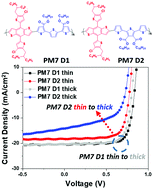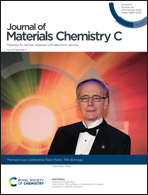Investigating the active layer thickness dependence of non-fullerene organic solar cells based on PM7 derivatives†
Abstract
Power conversion efficiencies (PCEs) in organic solar cells (OSCs) have rapidly improved in the last 5 years owing largely to the development of novel small-molecule acceptors and polymer donors with several systems’ performances exceeding 17%. A key factor for these materials implementation into industrial relevant devices is their active layer thickness tolerance as solar cell performances are typically reported with thicknesses on the order of 100–150 nm, but thicker films (ca. 300 nm) are needed for printing and roll-to-roll processing. In this report, two PM7 isomeric derivatives were synthesized featuring a chlorinated benzodithiophene and ester functionalized terthiophene moieties for the incorporation into non-fullerene OSCs. The fundamental difference between the two isomeric polymers is the location of the ester side chains where the PM7 D1 esters are located on the outer thiophene units, whereas the esters on PM7 D2 are located on the central thiophene unit. This simple modification produced polymers with similar absorption profiles, electrochemical onsets, charge carrier mobilities when blended with ITIC-4F, and grazing-incidence wide-angle X-ray scattering patterns. Thin-film (100 nm) OSCs were fabricated resulting in average PCEs of 11.6% for PM7, 12.1% for PM7 D1, and 9.9% for PM7 D2 when blended with ITIC-4F. In contrast, large differences are observed in PCE when the active layer thickness is increased to 180 nm resulting in a decrease in average PCE for PM7 D2 (5.3%), whereas PM7 D1 was able to retain a 11.9% average PCE. The difference in active layer thickness tolerance between PM7 D1 and PM7 D2 is rationalized by extracting the energetic disorder (σ) for hole transport using temperature dependent space-charge limited current studies. In the end, this study conveys how small changes to polymer structure, such as side chain placement, may have a small effect on thin-film polymer properties and device performance, but significant differences are realized when charges are transported over longer distances (thicker films, >150 nm).

- This article is part of the themed collection: Celebrating Tobin Marks’ 75th Birthday


 Please wait while we load your content...
Please wait while we load your content...